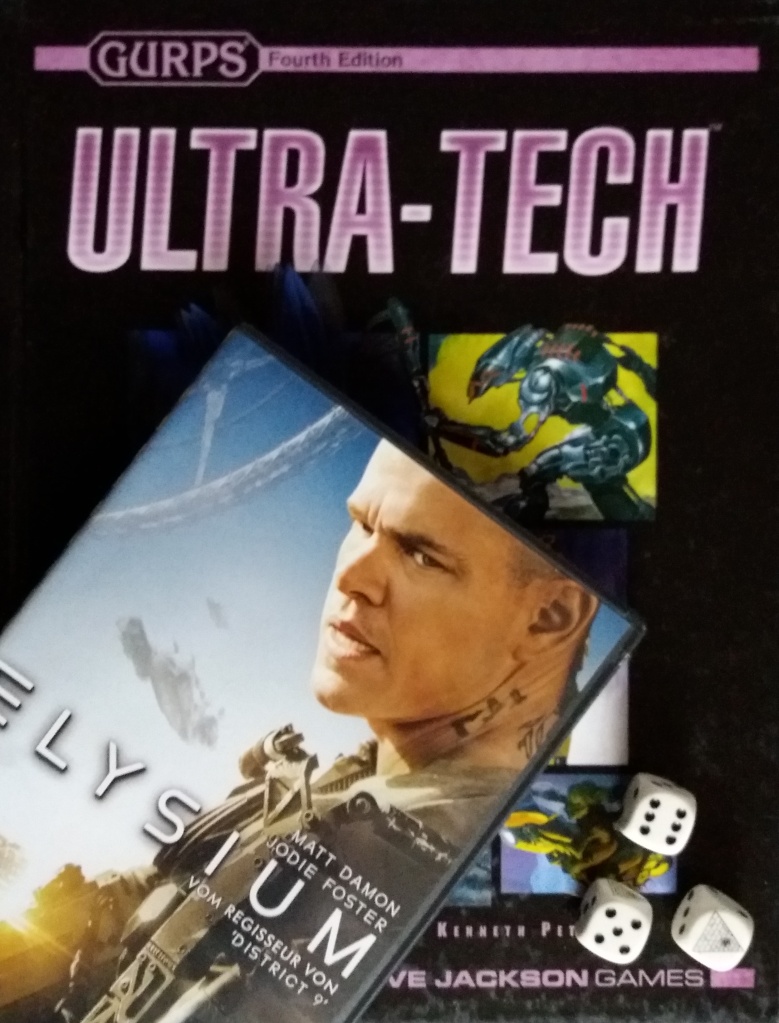Para uso único Asgari. [For Asgari Use Only.]
‒ User label of the TST ChemRail
Elysium (2013) is one of the more credible attempts at a cyberpunk film, even though many concepts of that genre are so 1980s. Perhaps to make up for this, the film is set in the much more distant future, the year 2154. Nevertheless it features many of the typical cyberpunk tropes, such as the juxtaposition of the sprawling masses and the filthy rich, the wonky cyber gear including datajacks and exoskeletons, the almost instantaneous computer hacking, an orbit community, etc.

And of course it has the weaponry, a mix of the antique – a katana (if that is not taken straight from Shadowrun’s street samurai then it is an incredible coincidence …), an Izhmash AKM assault rifle, and a Remington Model 870 pump-action shotgun, both with homing rounds – and the ultra-modern – Cousar Crowe storm carbines with ETC ammunition and 4Sure manportable ground-to-space multiple missile launchers.
The most fun, if not the most realistic, weapon featured in the film is the TST ChemRail Dual-Stage Linear Motor Rifle (LMR) – a variant of the portable rail gun (GURPS Ultra-Tech, p. 141).
Watch it being used by our protagonist “Max” da Costa (“Matt” Damon) here:
The ChemRail is apparently made by TST in Brazil, at least that is suggested by its Portuguese markings (perhaps based on Taurus Arms?). It uses both caseless ammunition and a magnetic rail, in what is called an injected rail gun. In other words, the projectile is initially launched by a chemical propellant and then accelerated by a magnetic rail along the barrel. This reduces the otherwise considerable erosion of the rail when fired from a standing start. The ChemRail fires the 8.75×52mm caseless cartridge and uses a Fin-Stabilised, Discarding Rail Accelerator Sabot (FSDRAS). This is a long, fin-stabilised, non-magnetic projectile – probably of tungsten carbide – that achieves a very high muzzle velocity due to a magnetic sabot. Accompanying sales materials claim that it has a muzzle energy of 18 Kilojoule (kJ). This means about Damage 5d×3(3) cr pi. The magazine in front of the grip holds the cartridges, probably around 20 by its size. The receptacle under the stock takes the power source.
There is an integral optical sight, no doubt something like a compact targeting scope (Ultra-Tech, p. 149), almost certainly with the added features mentioned in “Tactical Shooting: Tomorrow” (Pyramid #3/55, p. 10). There are accessory rails (Ultra-Tech, p. 150) on the top and underside of the muzzle, but the former would appear to be useless since mounting anything on it would obscure the sight picture of the scope. A vertical front grip makes handling the bulky weapon a bit easier (GURPS Tactical Shooting, p. 75).
Weirdly, the ChemRail is full-auto only – there is no single shot option. This seems like a very odd choice considering how powerful each individual shot, how limited the magazine and power capacity is, and how difficult to control the weapon appears to be. It also goes very much against current tactical doctrine (Tactical Shooting, p. 16, and Pyramid #3/55, p. 5), but who knows, things might change considerable over the next 130 years or so. The cyclic rate of fire from the sound of it should be around 800 rounds per minute (RoF 13!).
Rifles Table
See pp. B268-271 for an explanation of the statistics.
GUNS (RIFLE) (DX-4 or most other guns at -2)
|
TL |
Weapon |
Damage |
Acc |
Range |
Weight |
RoF |
Shots |
ST |
Bulk |
Rcl |
Cost |
LC |
Notes |
|
10 |
TST ChemRail, 8.75×52mmCL |
5d×3(3) pi |
4 |
3,000/12,000 |
20/1.5 |
13! |
20+1(3) |
10† |
-6 |
3 |
$18,000/$100 |
1 |
[1] |
[1] Powered by a C cell.
